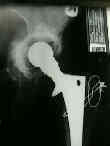- See:
- Acetabular Component Loosening:
- Bone Grafting for Acetabular Defects:

- Press Fit Acetabular Components:
- if possible, probably most primary and revision components should have press fit components;
- contained acetabular defects can generally be treated by grafting and insertion of a hemispherical acetabular
component with use of screws;
- generally only 70% coverage is necessary for fixation;
- bulk grafting generally cannot be used in press fit components, since bone ingrowth cannot be expected to occur;
- as noted by Padgett, et al (1993), using cementless acetabular components with screws, there was gross loosening (which required revision)
in only 5% of patients at 3-6 year follow up;
- gap cup:
- most indicated for acetabular revisions with non contained defects;
- in the report by Templeton JE, et al (2001), the authors evaluated 61 consecutive revision total hip arthroplasties
were performed in 51 patients because of aseptic failure of one or both components of a prosthesis in which both components
had been cemented;
- 28 patients (thirty-two hips) were alive at a mean of 12.9 years (range, 11.5 to 14.3 years) after the operation;
- in all of the patients, the acetabular component was revised to a porous-coated Harris-Galante component inserted without
cement, and the femoral component was revised to an Iowa component affixed with contemporary cementing techniques;
- none of the acetabular components required revision because of aseptic loosening;
- 2 hips (3%) demonstrated radiographic evidence of aseptic loosening of the acetabular component;
- polyethylene liner was exchanged during the follow-up period in eight hips;
- references:
- Revision of the acetabular component without cement after total hip arthroplasty. Three to six year followup.
- Ten years of experience with porous acetabular components for revision surgery.
- Noncemented acetabular revision arthroplasty using allograft bone.
- Acetabular preparation in cementless revision total hip arthroplasty.
- Revision of the acetabular component with an uncemented Harris-Galante porous-coated prosthesis.
- Revision of the acetabulum without cement with use of the Harris-Galante porous-coated implant. Two to eight-year results.
- Revision of a Cemented Acetabular Component to a Cementless Acetabular Component. A Ten to Fourteen-Year Follow-up Study

- Cemented Acetabular Components:
- components are typically all polyethylene;
- generally cemented components are inserted when contact area decreases below 30-50 percent;
- w/ contained medial wall defect, consider applying Vitallium mesh over morselized bone graft (placed medially);
- cement is then applied over the Vitallium mesh;
- as noted by Schreurs, et al. (1998), 60 cemented acetabular revision were followed for a mean of 11.8 years;
- over all survivorship was 90% (excluding infection survivorship was 94%);
- components were revised with impacted morselized bone allograft and a cemented polyethylene cup;
- segmental defects of the medial acetabular wall were closed with a cortical slice of allograft;
- the authors emphasize that the impaction grafting must be tight enough to achieve stability;
- complications:
- early loosening and need for early revision:
- whether or not allograft is used, surgeons should expect to find high rates of progressive radiolucencies, early loosening, and early need for revision;
- as noted by Kavanaugh and Fitzgerald (1987), 70% of cemented acetabular revisions developed progressive radiolucencies;
- these authors noted a 10% failure rate at 2 years;
- references:
- Multiple revisions for failed total hip arthroplasty not associated with infection.
- Salvage total hip reconstruction in patients with major acetabular bone deficiency using structural femoral head allograft.
- Long term results of revision total hip arthroplasty with improved cementing technique.
- Acetabular reconstruction with impacted morsellised cancellous bone graft and cement. A 10-15 year follow up of 60 revision arthroplasties.
- The all polyethylene cemented socket may still be the best choice.
Original Text by Clifford R. Wheeless, III, MD.
Last updated by Clifford R. Wheeless, III, MD on Saturday, February 16, 2013 9:34 am

